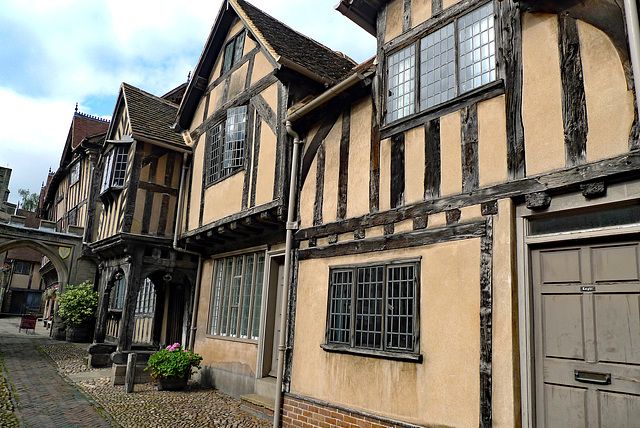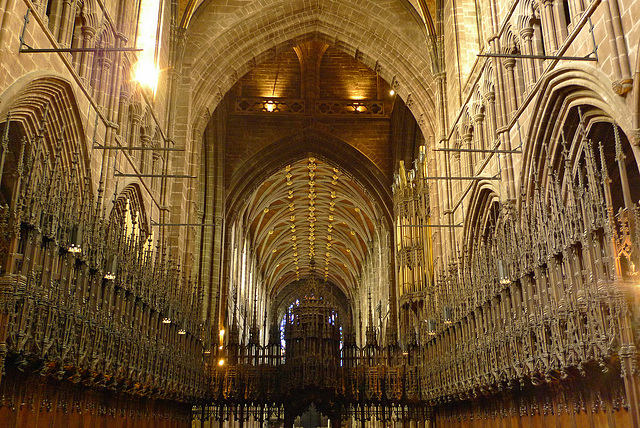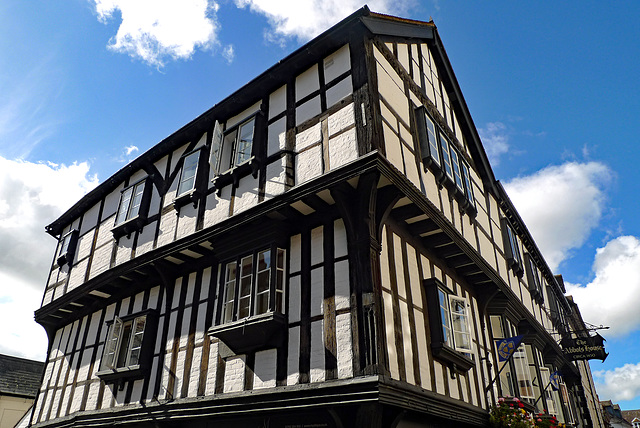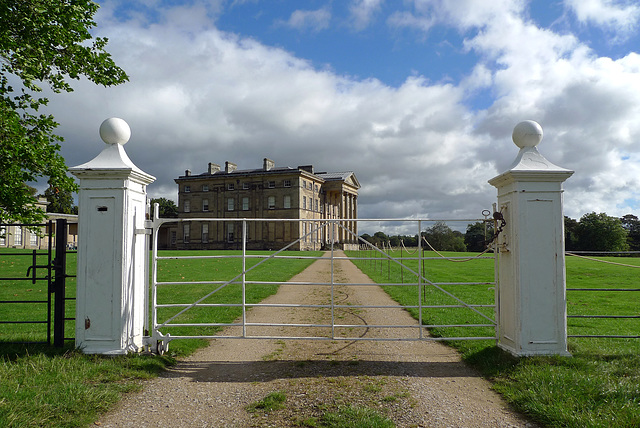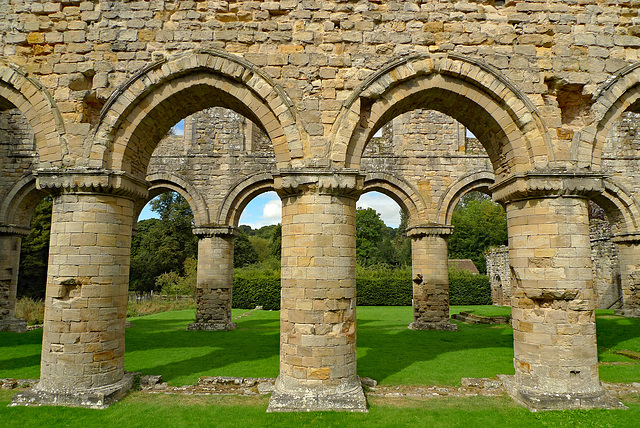
Engeland & Wales
England - Althorp
Althorp is a wonderful stately homen and an estate of about 5.300 ha. It has been held by the prominent aristocratic Spencer family for more than 500 years and has been owned by Charles Spencer, 9th Earl Spencer since 1992. Althorp House (main picture and PiP 1) was a classical red brick Tudor building, but its appearance was radically altered, starting in 1788, when extensive changes were made. The house is surrounded by a formal garden and a walled park.
Althorp was also the home of Lady Diana Spencer, later Princess of Wales, before her marriage to Charles, Prince of Wales. After her dead she was interred - 06.09.1997 - on a small island in the middle of the so called Round Oval Lake (PiP 2). A Doric-style temple with Diana's name inscribed on top is situated at the edge of the pond.
England - Warwick, Lord Leycester Hospital
The Lord Leycester Hospital has never been a medical establishment. The word hospital is used in its ancient sens, meaning ‘a charitable institution for the housing and maintenance of the needy, infirm or aged’.
In 1571 Robert Duydley, Earl of Leicester, founded a retirement home for disabled soldiers and their wives. His ‘hospital’ was set up in buildings which were already more than 150 years old, when it was the home of Warwick’s medieval guilds.
The hospital, now a self-supporting charity, continues to provide a home for ‘the Brethen’, as they are still known. They make together with their wives a key contribution to ensuring that this architectural gem is accessible for visitors.
England - Chester Cathedral
Chester Cathedral is an ancient abbey and a remarkable building of international importance that has played a significant role in shaping the history of Chester.
There have been churches on the site of the Chester Cathedral for some 1.400 years. After the departure of the Romans, churches were built by the Saxons. In the year of 907 a church dedicated to the Anglo-Saxon princess St. Werburgh was constructed. The church housed her remains and pilgrims made their way to the cathedral.
In 1092 a Benedictine abbey was founded by the Normans. The monastery remained on the site for nearly 500 years until King Henry VIII ordered the dissolution of the monasteries in England. Fortunately the king handed the monastic buildings back to serve as the cathedral church of the new diocese of Chester in 1541.
Over the centuries much of the soft red sandstone has become eroded and much of what we see today is the result of enthusiastic restoration during the Victorian period.
The interior offers some treasures of national significance, including the finest pinnacled medieval choir stalls (main picture), dating back to the late 14th century.
England - Warwick, Beauchamp Chantry.
The Beauchamp Chapel is considered being the finest medieval chapel in England. The chapel, situated at the south-east of the Collegiate Church of St. Mary, was built at the behest of Richard de Beauchamp (1382–1439), 13th Earl of Warwick, a nobleman and military commander.
Richard de Beauchamp's will was made in 1437 and two years later he died. Most of his property was entailed, but with a portion of the rest the will established a substantial trust. The trust endowed the St Mary’s Church and called for the construction of a new chapel there. Construction started shortly after his death with the foundation stone being laid in 1443; the chapel was completed in 1462. In 1475 the body of De Beauchamp was transferred to this family mausoleum.
The Beauchamp Chantry is composed of three bays, at the centre of which is the tomb of Richard de Beauchamp with its gilt-bronze monumental effigy. Beside the tomb of Earl Richard is that of Ambrose Dudley, whose effigy wears a gilded iron coronet (PiP). But the grandest tomb of is that of Robert Dudley, Earl of Leicester and his wife Lettice. His tomb is set into the north wall of the chapel, beneath a gilded canopy.
England - Shrewsbury, Abbot’s House
Most of the timber framed houses in Shrewsbury are dating back to the 15th and 16th century and were erected in the ‘golden years’ of wool trade in the city.
Abbot’s House in Butcher Row in the centre of town is one of the oldest timber framed houses in Shrewsbury. The house was built in 1459 by the Abbot of Lilleshall as an investment for his abbey. The windows at the bottom of were all separate butchers' shops, used until the mid-1800s; on the floors were tenements.
England - Atcham, Attingham Park
The mansion was built in 1785 for Noel Hill, first Baron Berwick. Noel Hill already owned a house on the site of Attingham Park called Tern Hall, but with money he received along with his title he commissioned an architect to design a new and grander house to be build around the original hall. The new country house encompassed the old property entirely, and once completed it was given the name Attingham Hall.
Attingham Hall and its beautiful parkland were owned by one family for more than 160 years.
The Attingham Estate, comprising the mansion and some 650 acres, was gifted to the National Trust in 1947.
England - Buildwas Abbey
The Cistercian Abbey of St Mary and St Chad is dating back to the year of 1135 and was founded as a Savignac monastery. It was was inhabited by a small community of monks. The stone from which the abbey was built came from a quarry in the nearby settlement of Broseley. The main income for the abbey came from tolls charged on the adjacent bridge over the river Severn.
Located near the border of Wales meant the abbey was destined to have a turbulent history. Welsh Princes and their followers regularly raided the Abbey and on one occasion in 1406 even kidnapped the abbot. The abbey was closed in 1536 by the order of Henry VIII during the Dissolution of the Monasteries.
The remaining buildings - situated on the banks of the river Severn - are now in the care of English Heritage and are open to the public. They can view the church, which remains largely complete and unaltered since its construction, although it is now without its roof.
The impressive ruins are considered being one of the best preserved 12th-century examples of a Cistercian church in Britain.
England - Melverley, St. Peter’s Church
St. Peter’s Church in Melverley is situated on the banks of the River Vyrnwy. The church was rebuilt in 1406 to replace the wooden chapel, which was burnt down during the Welsh uprisings in 1401. All that remains of the old building is the Saxon font, which is still used for baptisms today. It features also a Jacobean pulpit and a lectum (1727) with a chained bible.
The current timber-framed, wattle and daub, black and white church is one of only three such churches to be found in Shropshire and one of twenty-seven in England and the oldest of its kind. There is not one nail in the building.
Wales - Pontcysyllte Aqueduct
Pontcysyllte Aqueduct was built by Thomas Telford between 1795 and 1805. The aqueduct over the valley of the River Dee has 18 pillars; the highest ones come 38 meters above the water.
The Llangollen Canal runs over the aqueduct through a cast iron trough, which is more than 300 meters long, 3,7 meters wide and 1,6 meters deep; just enough for the narrow boats. Pontcysyllte Aqueduct is the longest and highest in Great Britain. The aqueduct carries a water passage for a single canal narrow boat as well as a towpath for pedestrians. It connects the Welsh villages of Froncysyllte and Trevor.
Pontcysyllte Aqueduct and the length of the Llangollen Canal from the Horseshoe Falls to Gledrid Bridge is now a World Heritage Site.
Jump to top
RSS feed- Latest items - Subscribe to the latest items added to this album
- ipernity © 2007-2024
- Help & Contact
|
Club news
|
About ipernity
|
History |
ipernity Club & Prices |
Guide of good conduct
Donate | Group guidelines | Privacy policy | Terms of use | Statutes | In memoria -
Facebook
Twitter



